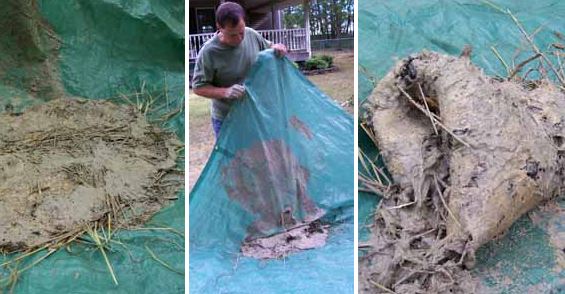Survival cement is a mixture of straw, mud and water; done properly, it can last for thousands of years (and has.)
Here are the basic steps in making survival cement.
1. Find a source of mud with as high a clay content as possible ‘If you smush some of the mud into a ball and it retains it's shape, you should be good.) and fill up a bucket with it — more if you are planning a large project.
2. Harvest a big armload of grasses, preferably dry — more if you are planning a large project — and cut them into lengths of about 6-12 inches.
3. Hydrate to your clay to a point where it will squish, not run, easily through your fingers. The consistency must be wet enough that it can be molded, but not so watery that it will not hold it's shape. Wetter mixes are good for mortar between stones, firmer for making bricks and solid survival cement structures, firmer still for wrapping food.
4. Spread a tarp on the ground and place the bucket of mud and the grasses at the edges of the tarp.
5. Dump the mud out of the bucket into the center of the tarp and place about half of your grass on top of the mud.
6. Get barefoot, and begin to stomp the grasses into the mud. Or, if you're not inclined to get your feet dirty, do like Eddie and fold a corner of the tarp over top and stomp on that!
7. Once the mud/grass mixture has spread out and flattened, step off the tarp and fold it in half, turning the mixture back onto itself. Do this a couple of times until it has formed back into a sort of ball.
8. Add the remaining grass and start stomping once again. Continue to repeat this process until the grass has been thoroughly combined into the mud. You want the grass to be between 40%-60% of your mixture, depending on the project.
9. Begin your survival cement project immediately, as once it begins to dry out the mud will harden and be difficult to mold. In these photos Eddie is fashioning a mud brick for an upcoming project.
In all likelihood, it would be a dire situation where you had to resort to using survival cement; if you did, however, knowing how to make it guarantees you the ability to build a very strong, durable substance and it is also a great skill for bartering!
By following the instruction above, your survival cement will last for years – likely far beyond the duration of whatever it is you are facing!
To learn more about survival cement and its many uses, please visit Practical Primitive.
Featured Image via Practical Primitive
